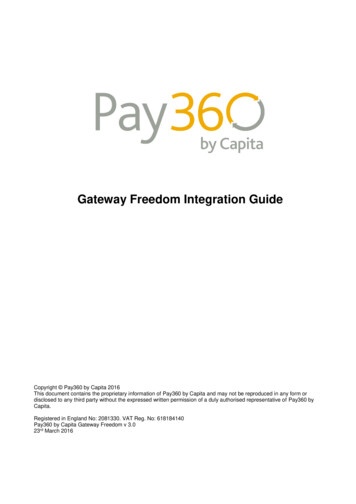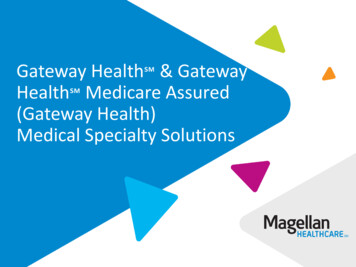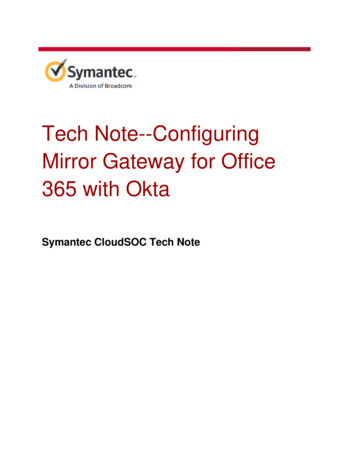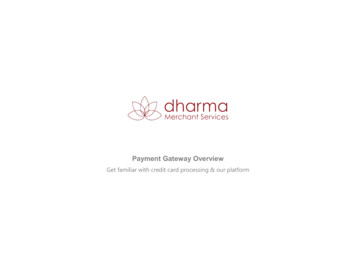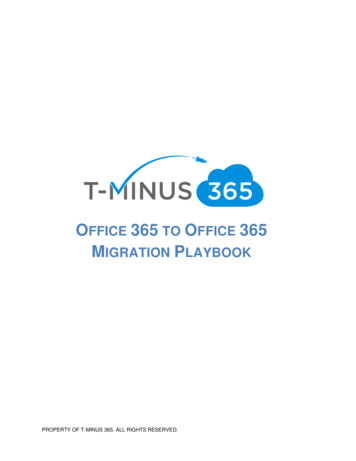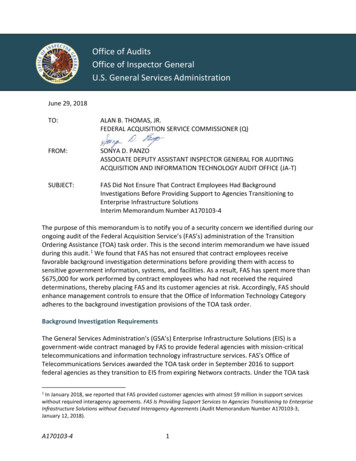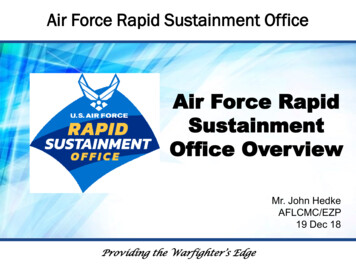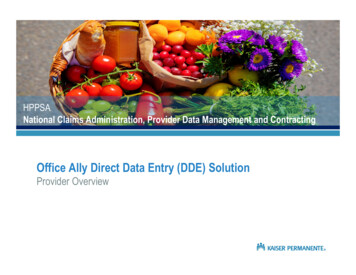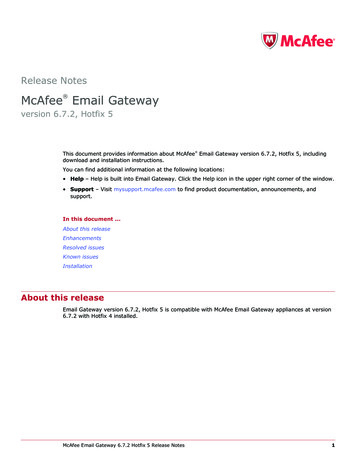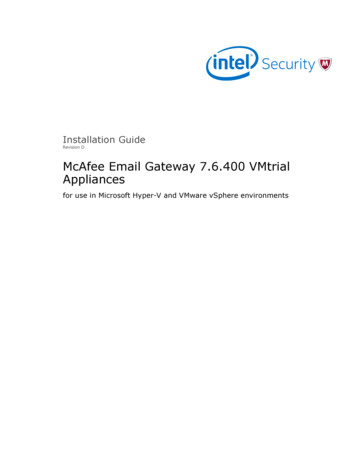
Transcription
PayPoint Gateway OverviewNC Office of the State ControllerRevised February 1, 2015What is the PayPoint Gateway?PayPoint is a web capture gateway solution available from First Data Government Solutions (FDGS) throughSunTrust Merchant Services (STMS). The service is an optional gateway service that may be subscribed tounder OSC’s master contract with STMS.What are the two primary payment processes offered by PayPoint?PayPoint’s consumer interface feature offers an agency the ability to accept online payments from citizens(consumers) and process them through one of two options. The option utilized depends upon who willauthenticate the attempted payment, the agency or PayPoint. Under each option, the citizen accesses theagency’s website first.Authentication performed by agency – Agency authenticates an attempted payment to aninternal database of open transactions, and if there is a match, the citizen is then redirected toPayPoint allowing him/her to select the payment method to complete the transaction.Authentication performed by PayPoint – From the agency’s website, the citizen is initially redirectedto a PayPoint hosted website, where the authentication process is performed against a databasemaintained at PayPoint, and if there is a match, the citizen can select the payment method tocomplete the transaction.How is PayPoint made aware of the open transaction(s) for which a payment may be initiated? Thiswill depend upon who performs the authentication function, the agency or PayPoint.Authentication performed by agency – The Advanced Query String process (real-time secure WebHTTP) is utilized. Upon a successful match on the agency’s website, the agency passes the opentransaction data to PayPoint, where the transaction can then be completed by the citizen selectinghis/her payment option. PayPoint does not maintain a database of open transactions, as it onlydisplays and acts upon the single query string message submitted by the agency.Authentication performed by PayPoint – The Data File Upload process (a batch file upload) isutilized. The agency submits to PayPoint a file containing all open transactions though a secure FTPbatch file upload process. The agency must keep the open transactions file updated in order forPayPoint to be able to authenticate attempted payments. PayPoint retains each open transaction inthe database flagged as open until the transaction is either paid, or later deleted by the agency.Additionally, at any time through the Admin feature, the agency can manually update the opentransactions file in the database maintained at PayPoint (add or delete an open transaction). (Thebatch file upload made through the Consumer Interface module is not to be confused with the APIBatch File process associated with the API module referenced in PayPoint’s manuals.)How is the agency made aware of successful payments initiated through PayPoint?There are three possible ways of receiving the payment results, depending upon which interface option isutilized for submitting open transaction data to PayPoint (Refer to page 10 for further discussion.): Posting File - Agency downloads a posting file, normally the next business day, either manually orvia an automated process. (Applies to both methods of submitting open transaction data toPayPoint.) Detail Payment Transaction Report – Agency runs and retrieves transaction reports through theAdmin screen. (Applies to both methods of submitting open transaction data to PayPoint.) Query String Return Call – For each query string (Query Call) submitted to PayPoint, PayPointcommunicates back to the agency’s return URL (Return Call), upon either the success or failure ofthe attempted payment. This Return Call is real-time and allows the agency to update its database ofopen transactions as payments are made at PayPoint. (Applies only to the Advanced Query Stringmethod of submitting open transaction data to PayPoint.)
Comparison of the two methods of transmitting open transaction data to PayPointConsultation with OSC and/or First Data and consideration of the agency’s needs are required in order toselect the appropriate method. The two methods are: 1) Advanced Query String (Secure Web HTTP); and2) Data File Upload. Below is a comparison of the two methods associated with the Consumer Interfacefeature.Comparison of Two Transmission Methods w/ Consumer Interface FeatureReal AuthentiProsConsAgency’s RoleTimecationAdvanced Yes OnMaintains agency website for Database ofAgency has todevelop web form toQueryAgency’s authentication of A/R (invoice openID and amount) before being transactionscapture transactionStringwebsiteforwarded to PayPoint for does not have to on agency’s websiteselection of payment method be maintained(Secureand be keptAgency has toWEBdevelop program toupdated onHTTP)Invoice data is transferred toPayPoint’sauthenticate againstPayPoint to be displayed toserversagency-maintainedpayer only when payer’sdatabase, and if aonline-entered data ismatch, submit queryReceipt ofauthenticated by agency,string to PayPointpaymentthereby allowing payer tonotification fromselect payment methodPayPoint is real- Agency has totime via returned program to receiveAgency receives responsequery stringReturn Call resultsreal-time from PayPointwhen payment isauthorized/rejectedData FileNoOnCreate open A/R transactionNoDatabase atUploadPayPoint file and upload to PayPoint,programmingPayPoint must bewebsitekeeping database maintained needed formaintained and kept(Batchat PayPoint updatedagencyupdatedData File)authenticationUpload can be via FTP toRequires SecureFirst Data’s secure FTPFTP upload,Receipt ofserver or through PayPoint’sgenerally dailypaymentAdmin screennotification canbe real time,Receipt of paymentbut only if anAgency’s website has a linknotification fromoptional “Postto PayPoint, where payerPayPoint not realAuthorizationenters all payment data,time, only whenplug-in”resulting in PayPointretrieval of postingmodule isperforming authenticationfile is downloaded,obtainedbased on open transactionsor transaction data(customizationdatabase, and offeringviewed via Adminrequired)payment method to payersiteMethodFiles must be created in aformat specific to theagency. Data encryptionsoftware must be used suchas WinZip or others that areSSL 128 bit compatible.
What features are available via the two PayPoint Consumer Interface Option?Advanced Query StringStandard FeaturesPayment GatewayConsumer InterfaceDatabaseAuthenticationPortal BuilderAdmin SiteVirtual TerminalPosting FileApplication hosted by First DataPayments entered on PayPoint via WebOn agency’s websiteOn agency’s websiteUsed by agency to design siteUsed by agency to perform variety of functionsAgency can key transactions via Admin screenDownloadable (completed transactions)Total Basic Fees Per TransactionFor transactions entered via PayPoint’s Admin site (Virtual Terminal),the .10 per transaction fee does not apply.Optional FeaturesSummaryNot normally applicable under Query StringPresentmentEnrollmentNot normally applicable under Query StringPayPointFee .08 / Trans .02 / TransN/AN/AIncludedIncludedIncludedIncluded .10N/AN/AData File UploadStandard FeaturesPayment GatewayConsumer InterfaceDatabaseAuthenticationPortal BuilderAdmin SiteApplication hosted by First DataPayments entered on PayPoint via WebOn PayPoint’s websiteOn PayPoint’s websiteUsed by agency to design siteUsed by agency to perform variety offunctionsVirtual TerminalAgency can key transactions via Admin sitePosting FileDownloadable (completed transactions)Total Basic Fees Per TransactionFor transactions entered via PayPoint’s Admin site (Virtual Terminal),the .10 per transaction fee does not apply.Optional FeaturesFeatures below not used with Query StringSummary Presentment Users can be displayed both unpaid andpaid invoices. (With Registration/Enrollmentfeature only.)Registration/EnrollmentReoccurringUsers can be enrolled on PayPoint,allowing users’ self-service to updateuser’s profile, payment method(s), ability toview history of prior transactions, and toinitiate reoccurring payments (if offered)User can be setup to schedule payments tobe auto-made against card or bank accounton filePayPointFee .08 / Trans .02 / TransIncluded .05IncludedIncludedIncludedIncluded .15 .10 / trans .02 perenrollmentWithenrollmentonly
What are the major benefits of PayPoint?PayPoint has a consumer interface, which has a web capture feature as part of the solution.Multiple Payment Options – PayPoint allows the site visitor to select one of two payment options –credit/debit card or ACH bank draft (E-Check)When is PayPoint suitable for an agency?Agency desires to accept payments online, but does not have the internal resources and/orexpertise to develop a comprehensive in-house web capture applicationAgency desires to utilize a third-party gateway service provider to minimize (but not completely avoid)applicability of the PCI Data Security Standard requirements, primarily by avoiding the agency everhaving to store cardholder data in the agency’s databaseAgency desires to offer both the ACH bank draft payment option (E-Check), in addition to the cardoption; or to just offer one of the optionsAgency has outstanding invoices (accounts receivable transactions) associated with payers, whichare conducive to being authenticated online-real time, either on the agency’s website or onPayPoint’s website, before being accepted and transacted via PayPointIs PayPoint the gateway of choice for an agency needing gateway services?OSC’s policy states, “Agencies requiring a gateway service in order to participate in the MSA(s) may select asecure gateway service of its choosing, provided it acquires approval from OSC and adheres to all applicableprocurement requirements.”PayPoint is just one of several third-party gateways that an agency may elect to utilize. Some third-partygateways specialize in certain types of transactions that are more suitable for the agency. For example, somespecialize in tuition payments and some in online reservations. The agency must also consider whichgateway is compatible with its accounting system (e.g., PeopleSoft or Banner for the universities and Datatelfor the community colleges). While there are two gateway capture solutions available through OSC’s mastercontract with STMS (PayPoint and First Data Global Gateway), an agency is not required to utilize either, justas it is not required to obtain POS terminals from STMS. Utilization of PayPoint does not require the agencyhaving to issue an RFP.When is the PayPoint gateway service more appropriate to use than the Global Gateway?PayPoint is a recommended solution for an agency that needs a “consumer interface” feature. The FirstData Global Gateway solution (formerly called YourPay) offered by STMS does not have a web consumerinterface feature. PayPoint is more suitable for agencies that have accounts receivable transactions thathave been invoiced to a payer and can be authenticated online before being paid (either by the agency orby PayPoint). PayPoint is also suitable when the agency desires to offer bank draft (E-check) as a paymentoption, in addition to the credit card option; or to only offer the E-check option (suitable for large paymenttransactions).Does PayPoint accommodate card-present transactions and MOTO?Yes, in addition to accommodating web-initiated payments by the consumer, PayPoint can also function as a“virtual terminal” solution, with the agency initiating the payments through the agency’s Admin PC screen. Thiscould be for walk-ins (card-present) or for mail orders / telephone orders (MOTO). The normal capture methodwould be for the agency personnel to key the cardholder data or check data (for bank drafts) on the Admin PCscreen while connected to the PayPoint website in a secure session. PayPoint provides for a customer receiptto be printed, which can be provided to the payer (in person, or emailed). Card capture via a magnetic stripereader connected to the agency’s PC is an alternative to the agency personnel keying the card data onto thePC screen. For transactions entered through the Admin screen, the .10 per transaction Consumer Interfacefee does not apply.Using a gateway as a virtual terminal does have certain PCI Data Security compliance implications, ascardholder data is being “processed” at the agency’s location, via a device connected to the Internet. Thedegree of implications depends partially upon rather the PC is segmented from other agency servers or not.Agencies utilizing PayPoint as a virtual terminal must have the associated external IP addresses enrolled in
Coalfire so that the external facing (public) IP addresses can undergo quarterly vulnerability scanning.Are there other ways of utilizing PayPoint involving an API solution?While PayPoint does offer an API (Application Programming Interface) solution, which does not utilize theConsumer Interface feature, it is not the recommended utilization of PayPoint for agencies, as it requiresmore agency website maintenance and greater PCI Data Security compliance implicationsWhat type of technical knowledge must an agency have?IT expertise that is needed by an agency will depend largely upon the type of interfacing of transaction databetween the agency’s transaction database and the PayPoint application. Minimal technical knowledge isneeded in developing the web portal on the PayPoint server through the consumer payment module.However, IT staff will be involved in the setup of the upload process of open transactions to PayPoint [i.e.,either: 1) Advanced Query String involving Web HTTP; or 2) Data upload/download files]. Knowledge of FTPfile upload/download (ASCII), and advanced query strings are helpful when determining which methods ofinterfacing data (to and from PayPoint) are to be utilized. There are several methods of uploading anddownloading of data to/from PayPoint available. The handling of data received from PayPoint (posting file ordetail transaction report) can either be interfaced or manually posted. A review of PayPoint’s IntegrationGuides will give an agency an idea of the type of technical expertise needed.How is the consumer payments website designed?Using the Consumer Payments design toolkit (portal builder), for each payment application, the agency logson to PayPoint through the Admin screen and creates its own webpage. The toolkit allows for the agency touse its own agency logo, pick a theme, fonts, colors, headers, footers, and establish rules for the particularpayment. The site can be disabled as needed, such as to perform maintenance.How does PayPoint handle the agency’s logo?The PayPoint application links to the agency’s logo (gif or jpg) maintained on a secure server maintained byeither: 1) the State agency, or 2) First Data. If the URL link, which is provided during the setup, is not to asecure server (https), the consumers will get a security warning message when initiating payments.Therefore, unless the agency has a secure server to house the logo, the agency must provide the GIF orJPG logo to First Data for hosting.Are there any start-up fees for the agency?As of February 1, 2015 when the terms of our new contract with STMS went into effect, there are noimplementation fees.Are there any on-going transaction fees?STMS Amendment Number 2 contains the fee schedule. Transaction fees will vary based upon which of thetwo transaction interface options are utilized, and which additional features are utilized. The two basic pertransaction fees that apply are: 1) Gateway transaction fee - .08; and 2) Consumer Interface surcharge fee .02. The .02 surcharge does not apply for transactions entered via the agency’s Admin screen. If the DataFile Upload interface feature is used, which requires authentication on PayPoint’s website (instead of on theagency’s website), an additional .05 authentication/challenge fee would apply.What additional “other” on-going transaction fees could apply?A “Summary Presentment Surcharge” fee of .10 per transaction would apply if the agency wishes forpayers to be displayed billing data (both paid and unpaid invoices) associated with the payer’s ID. An“Enrollment” fee of .02 per registration/enrollment would apply if the agency wishes for the payers to beable to pre-enroll and maintain their own online profile (see below). The PayPoint fees would be in additionto any fees associated with processing card transactions through STMS, which involve interchange andassessment fees charged by the card brands.Are fees for PayPoint services separate from fees for processing card transactions?Yes. Services for fees associated with PayPoint will be invoiced by First Data Government Solutions, whileservices for processing card transactions will be invoiced by SunTrust Merchant Services (STMS).
Is there a payer Registration / Enrollment feature?PayPoint offers the ability for payers to register in PayPoint, establishing an online payer profile. This featureis available at either the agency or application level. There are both advantages and disadvantages tooffering this option. Advantages include: 1) Payer has the ability to view history of previous transactions; 2)to store the card number or bank account number it desires to be used when making payments; 3) to enrollin re-occurring payments; and 4) to receive email confirmations when payments are made. Disadvantagesinclude: 1) UserID and password maintenance must be considered; 2) risk associated with expired cards orchanged bank accounts must be considered; 3) payer may confuse PayPoint profile with their profilemaintained on the agency’s records; 4) payer must logon to PayPoint whenever making a payment, even ifalready authenticated at the agency’s website; and 5) the feature cannot be used in conjunction with thequery string method.This feature may be appropriate if re-occurring payments are due from a payer (i.e., payment schedule isestablished), and then only if the Data File Upload method is used. If the registration/enrollment feature ischosen, a separate application is required, separate from the application for payers not being pre-enrolled.Are there any Interactive Voice Response (IVR) fees?PayPoint accommodates IVR, but there is no perceived demand for this service. Initially, PayPoint will beused primarily for “card-not-present” transactions, and ACH bank drafts (E-Checks) initiated through theWeb, as well as via MOTO (mail order telephone order). If you choose to use IVR, the fee is .08/minute.How are bank drafts (E-Checks) processed through PayPoint?While card transactions are routed through STMS for collection and settlement, bank draft transactions (alsoreferred to as E-Checks) are routed through TeleCheck, a business unit of First Data. TeleCheck functions asthe ACH originating bank, with ACH debits being submitted against the payer’s bank account, and theproceeds being credited to the agency’s designated bank account. The agency’s designated bank accountnormally is the same ZBA account the agency has with the State Treasurer for the settlement of its creditcard transactions (at Wells Fargo for agencies).Are there any fees associated with originating ACH bank drafts?No, there are not any ACH related fees beyond the basic PayPoint per transaction fees. Should the payerselect the bank draft option to initiate a payment (referred to as an “E-Check”), the agency avoids theinterchange fees associated with processing merchant cards.Can an agency elect to only offer the E-Check payment option for a particular application?Yes, this may be appropriate when the average transaction amount for a particular application (or set ofpayers) is normally very large, and the agency does not want to incur the interchange fee associated with acard transaction. (Interchange fees are based on a percentage of the amount of a card transaction.)When an open invoice transaction is displayed to a payer, can the payer change the amount field?Any of the fiel
OSC’s policy states, “Agencies requiring a gateway service in order to participate in the MSA(s) may select a secure gateway service of its choosing, provided it acquires approval from OSC and adheres to all applicable procurement requirements.” PayPoint is just one of several
